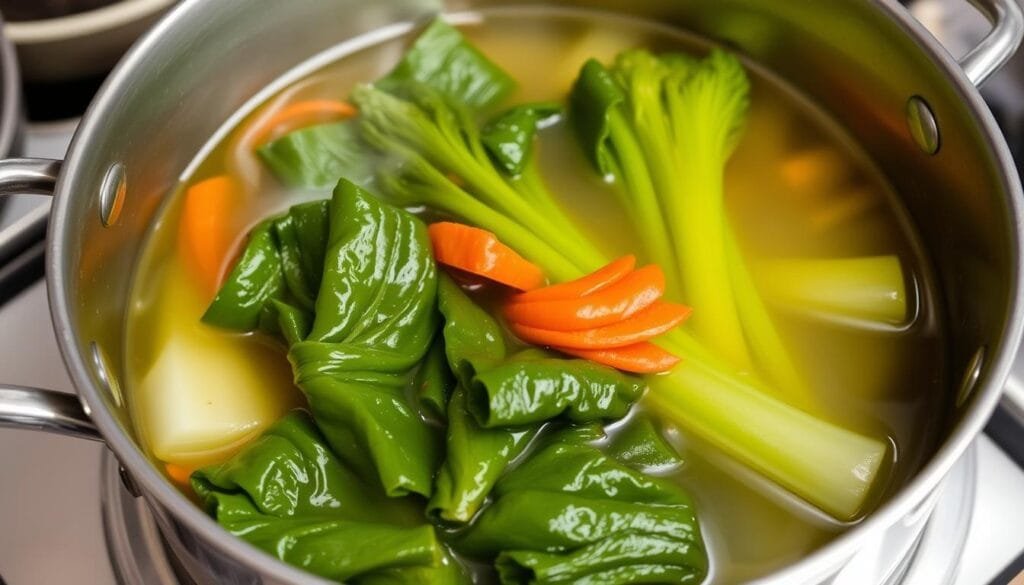Are you craving a warm, comforting, and flavorful meal? This vegetarian ramen recipe is perfect. It’s filled with fresh vegetables and a rich broth. It’s easy to make at home and very satisfying.
In just 25 minutes, you can have a delicious bowl of homemade ramen. The secret is the ginger, garlic, sesame oil, soy sauce, and mirin. They make a savory broth. Miso paste and mushrooms add more umami, making it rich and flavorful.
This homemade ramen recipe is easy to customize. You can make it your own way. It’s great for a cozy weeknight meal or a comforting bowl of noodles.
Understanding Plant-Based Ramen Essentials
Ramen, the beloved Japanese noodle dish, has long been a staple in many households. But what if you’re looking to explore a more plant-based approach? Fear not, as the world of plant-based ramen offers a wealth of delicious and nutritious possibilities.
Key Components of Authentic Ramen
At the heart of traditional ramen lies a trifecta of essential elements: a rich broth, chewy noodles, and an array of flavorful toppings. While the classic versions often feature animal-based broths and proteins, modern plant-based ramen recipes have stepped up to the challenge. They showcase the versatility of vegetables and plant-based ingredients.
Benefits of Plant-Based Alternatives
By embracing plant-based ramen, you can enjoy a host of benefits. These dishes offer a more sustainable and eco-friendly approach. They also cater to a growing demand for healthier food options. The Vegetarian Ramen recipe shared in 2015 has become one of the all-time most popular recipes, stemming from a plant-based ramen establishment in Kyoto known for its soy milk-based ramen. These meatless alternatives can provide a nutritious and satisfying meal, without compromising on flavor or authenticity.
Essential Kitchen Equipment
To craft the perfect plant-based ramen at home, you’ll need a few essential tools in your kitchen arsenal. A set of measuring cups and spoons, a large cooking pot, and a selection of ramen bowls will be your go-to companions. The Vegetarian Ramen can be prepared in approximately 30 minutes if the cold brew dashi is prepared beforehand. With the right equipment and a little preparation, you’ll be well on your way to creating your own plant-based ramen masterpieces.
“The world of plant-based ramen offers a wealth of delicious and nutritious possibilities.”
Creating the Perfect Umami-Rich Vegetable Broth
Making a vegan ramen broth full of umami is key to a great plant-based ramen. Mushrooms are the secret to rich, savory flavors. By simmering shiitake, cremini mushrooms, onions, garlic, ginger, and kombu, we get a broth as deep as traditional stocks.
First, I sauté onions, garlic, and ginger in sesame oil to bring out their flavors. Then, I add fresh and dried shiitake mushrooms to release their earthy umami. Mirin, rice vinegar, and white miso paste add more depth. After about an hour of simmering, the flavors blend for a remarkable vegan ramen broth.
This broth can be made ahead and kept in the fridge or freezer. Reheat it, add noodles and toppings, and enjoy a comforting, umami-rich vegan ramen.
“The key to a satisfying vegan ramen is a deeply flavorful, umami-rich broth. By focusing on mushrooms, we can create a truly remarkable vegetable-based alternative to traditional meat-based ramen.”

Broth Ingredients and Preparation
- Fresh shiitake mushrooms
- Dried shiitake mushrooms
- Cremini mushrooms
- Onions
- Garlic
- Ginger
- Kombu (edible kelp)
- Tamari or soy sauce
- Mirin (Japanese rice wine)
- Rice vinegar
- White miso paste
Simmering these ingredients for about an hour makes a flavorful mushroom broth. The mix of fresh and dried mushrooms, plus kombu, creates a broth full of savory, umami flavor.
Plant-Based Ramen with Vegetables: Step-by-Step Guide
Making a tasty plant-based ramen is like an art. It needs careful preparation, great flavors, and a bit of creativity. Follow this guide to make a delicious, healthy bowl of plant-based goodness.
Preparing the Base Ingredients
Begin by cutting your veggies into small pieces. Mince the garlic and grate the ginger for a strong aroma. Heat some sesame oil in a big pot or Dutch oven. Sauté the garlic until it’s golden, about 3 minutes.
Add the grated ginger and cook for another minute until it smells great.
Cooking Method and Timing
Pour in the vegetable broth and mix in the tamari and white miso paste. Let it simmer for 10 minutes, until the mushrooms are soft. In another pan, quickly cook the bok choy until it’s bright green and tender, about 2 minutes.
Assembly Instructions
Now, it’s time to put your ramen together. Cook the noodles as the package says, usually 2-3 minutes. Put the noodles in four big bowls. Then, pour the flavorful broth over them.
Place the sautéed bok choy, sliced carrots, and other toppings around the noodles. Sprinkle sesame seeds, sliced green onions, and a squeeze of lime juice on top. This adds a fresh touch to your dish.
With a bit of prep and this guide, you can enjoy a tasty plant-based ramen at home. Enjoy the mix of flavors and textures in this healthy and fulfilling meal.
Essential Ingredients for Authentic Flavor
Making a real plant-based ramen needs the right mix of Japanese ingredients and umami boosters. Soy sauce, mirin, rice vinegar, and miso paste are key. They add depth and complexity to the broth. Sesame oil brings a nutty smell, while kombu and mushrooms give that umami kick.
Fresh ginger, garlic, and scallions are vital for brightening the taste. The noodles, whether dried or fresh, are the meal’s core. Choosing the right noodles is essential for the perfect texture and slurp-ability.
A plant-based ramen isn’t complete without a rich vegetable broth. This broth is made by simmering veggies, spices, and herbs. It’s the base for your toppings and flavors.
For a spicy kick, add chili oil or sriracha. But the beauty of ramen is you can customize it. Try different ramen seasoning, Japanese ingredients, and umami enhancers to find your favorite flavor.
| Key Ingredients | Amount |
|---|---|
| Vegetable Oil | ¼ cup |
| Garlic | 4 cloves |
| Sesame Seeds | 1 Tbsp. (black or white) |
| Gochugaru or Crushed Red Pepper Flakes | 1 Tbsp. or 1½ tsp. |
| Scallions | 4 for garnishing |
| Ginger | 2″ piece |
| Tomato Paste | 2 Tbsp. |
| Dried Shiitake Mushrooms | 8 |
| Dried Kombu | one 4×3″ piece |
| Cold Water | 5 cups |
| Unsalted Butter | 3 Tbsp. |
| Low-Sodium Soy Sauce | 1 Tbsp. |
| Kosher Salt | As needed for seasoning |
| Baby Bok Choy | 4 (about 12 oz. total) |
| Fresh Ramen Noodles | 5-oz. packages |
With these ramen seasoning, Japanese ingredients, and umami enhancers, you’re set to make a plant-based ramen full of real flavor. Get ready to enjoy every slurp of your homemade ramen!
Choosing and Preparing Fresh Vegetables
Creating the perfect plant-based ramen starts with fresh, seasonal vegetables. Choose from crisp bok choy to earthy shiitake mushrooms. The right veggies can make your ramen taste amazing and feel great.
Seasonal Vegetable Options
Use the seasons to your advantage by adding different veggies to your ramen. Some top picks include:
- Bok choy – for its tender leaves and crunchy stems
- Shiitake mushrooms – for their savory, umami-rich flavor
- Carrots – for a pop of color and natural sweetness
- Spinach – for a nutrient-dense green element
- Bean sprouts – for a satisfying crunch
- Corn – for a touch of sweetness and texture
As the seasons change, try snow peas, baby corn, and broccoli. They add variety and color to your ramen.
Cutting and Preparation Techniques
Getting your veggies ready right is key for a great ramen. Slice mushrooms thinly, julienne carrots, and chop bok choy into small pieces. This helps them cook evenly and mix well. For greens like spinach, cook them separately to keep them tender.
Prepping your veggies ahead of time makes making ramen easier. It helps you enjoy the process without stress.

| Vegetable | Preparation |
|---|---|
| Bok Choy | Chop into 1-inch pieces |
| Shiitake Mushrooms | Thinly slice |
| Carrots | Julienne into thin strips |
| Spinach | Cook separately to maintain texture |
| Bean Sprouts | Leave whole for crunchy texture |
| Corn | Use fresh or frozen kernels |
By picking and preparing a mix of fresh, seasonal veggies, you’ll make a stunning and tasty plant-based ramen. It will impress your taste buds.
Mastering Ramen Noodle Selection and Cooking
Choosing the right noodles is key to making great plant-based ramen. You can pick from dried, fresh, or soba noodles. Make sure they are vegan-friendly, without eggs or animal products.
Dried ramen noodles are a top pick for their convenience. They cook in 2-3 minutes, making them quick for your ramen. Always follow the package instructions for the best texture.
| Noodle Type | Cooking Time | Texture |
|---|---|---|
| Dried Ramen Noodles | 2-3 minutes | Firm and chewy |
| Fresh Ramen Noodles | 1-2 minutes | Tender and silky |
| Soba Noodles | 4-6 minutes | Nutty and slightly firm |
Fresh ramen noodles offer a tender, silky feel. They cook in 1-2 minutes. This makes them perfect for a rich vegetable broth.
Soba noodles, made from buckwheat flour, have a nutty taste. They take 4-6 minutes to cook. They’re a tasty twist on traditional ramen.
It’s vital to cook noodles separately from the broth. This keeps them from getting soggy or clumpy. After cooking, rinse them in cold water. Then, toss with sesame oil to prevent sticking.
Learning how to pick and cook noodles is essential for great plant-based ramen. Try different types and methods to find your favorite.
Creative Toppings and Garnishes
Adding the right toppings and garnishes can make your homemade ramen bowl special. You can choose from traditional Japanese flavors or modern plant-based options. Let’s look at some tasty choices to enhance your ramen.
Traditional Japanese Garnishes
Classic ramen toppings mix textures and flavors. They balance the rich broth perfectly. Here are some traditional Japanese garnishes:
- Soft-boiled egg (ajitsuke tamago) – A creamy yolk and firm white for a nice contrast
- Nori (dried seaweed sheets) – Adds a savory umami flavor and crunch
- Bamboo shoots (menma) – Sweet, pickled, and crunchy
- Corn – Sweet and colorful
Modern Plant-Based Alternatives
For vegan or vegetarian ramen, there are many tasty plant-based garnishes:
- Baked tofu – Crispy outside, soft inside, and packed with protein
- Edamame – Fresh, crunchy soybeans for a burst of green
- Crispy shallots – Savory and crunchy
- Sesame seeds – Nutty flavor and texture, toasted or raw
Adding fresh garnishes like scallions, cilantro, and bean sprouts brings color and crunch. Crispy garlic chips and crushed peanuts also add texture.
For sauces and seasonings, offer chili oil, sriracha, or extra soy sauce. This lets diners adjust their ramen to their liking.

“The true beauty of ramen lies in the details – the perfect blend of flavors, textures, and unexpected garnishes that transform a simple dish into a symphony of culinary delight.”
Tips for Achieving Restaurant-Quality Results
To make your homemade ramen as good as a restaurant’s, focus on the small things. Use the freshest, best ingredients you can find. Homemade ramen tips say making your own broth is key. It gives you rich, complex flavors that store-bought stocks can’t match.
For ramen cooking techniques, cook veggies and noodles separately. This lets you control their texture perfectly. Try different miso pastes to add unique flavor enhancement to your tare (seasoning sauce).
- Add miso off the heat to keep the probiotics and flavors intact.
- Use ingredients like mushrooms, soy sauce, and roasted sweet potatoes to add umami.
- Enjoy your ramen right away to keep the noodles from getting soggy.
By focusing on these details, you can make your homemade ramen truly special. It will impress even the pickiest ramen lovers.

Storage and Meal Prep Recommendations
Enjoying plant-based ramen doesn’t have to end. With a little prep, you can enjoy it for days. Store the broth, noodles, and toppings separately to keep them fresh.
Refrigerate the broth for 3-4 days or freeze it for 3 months. Warm it gently on the stovetop when reheating. Cook noodles just before serving to avoid mushiness. Chop veggies in advance and store them in airtight containers.
For meal prep, keep components separate until serving. Reheat the broth, then add noodles and toppings. This way, every bite is as fresh and flavorful as the first. With planning, your ramen leftovers will taste just as good.
| Storage Guidelines | Meal Prep Tips |
|---|---|
|
|
Follow these meal prep ideas for storing ramen components. You’ll enjoy your plant-based ramen long after the first bite. Bon appétit!
Variations and Customization Options
Plant-based ramen offers endless customization options. Try different broths to find your favorite. Choose from classic miso, savory shoyu, or spicy Szechuan.
Experiment with noodles too. Instead of traditional ramen noodles, try udon, soba, or rice noodles for a new flavor.
Be creative with toppings to make themed bowls. Add kimchi, toasted sesame seeds, and crispy tofu for a Korean twist. Or, go for a Thai vibe with coconut curry broth and fresh veggies. For a Japanese touch, use scallions, nori, and a soft-boiled egg.
There are many protein choices. Swap tofu and tempeh for seitan or marinated mushrooms. Add lots of seasonal veggies like bell peppers, mushrooms, and greens. A toppings bar lets everyone make their ramen bowls special.







